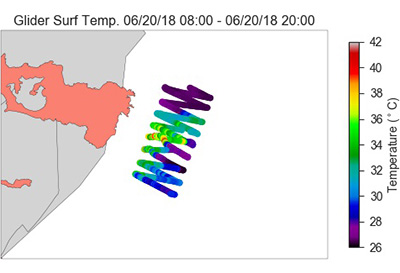Autonomous Thermal Front Tracking at the Kilauea Volcano Plume
Liquid Robotics — July 12, 2018
The Kilauea volcano eruption has presented a rare scientific opportunity to study the impact of the lava flow on the ocean. Last month we sent two Wave Gliders around Hawai’i’s Big Island to monitor the water conditions, air quality, and underwater acoustics, and data collection is underway.
But another opportunity presented itself: the chance to apply an autonomous front-tracking method developed by researchers at the Monterey Bay Aquarium Research Institute (MBARI).
Founded in 1987 by David Packard, MBARI is a leader in developing innovative technologies for studying and understanding the ocean. One of their latest innovations involves using a Wave Glider to autonomously detect and track thermal fronts based on the horizontal gradient of near-surface temperatures. In response to the Kilauea volcano event, MBARI researchers quickly applied the method to studying the thermal front between the lava-heated water and the colder surrounding water.
How It Works
The tracking method is based on a zigzag path. MBARI’s algorithm calculates the horizontal gradient of temperature in real time. When the gradient exceeds a threshold, the vehicle reports front detection, continues moving forward for a short time to cover the frontal zone, and then turns onto the next zigzag leg.

The tracking area is defined by a northeast-southwest oriented bounding box. When the vehicle hits the north wall, it switches to a southward sweep, and vice versa. This way, the Wave Glider zigzags through the front at high spatial resolution to map the front and track how it changes over time.
For this expedition, MBARI researchers made adjustments to the algorithm. For example, when the Wave Glider reaches a red-flag temperature, it turns onto the next zigzag leg to stay away from too hot water.
A Win-Win Collaboration
With this collaboration, the MBARI team was able to test their front-tracking method in a new environment, adapting their algorithm to account for the more extreme temperature variations. And as a result, our Liquid Robotics team benefited from increased assurance that we could protect the Wave Gliders and steer them away from water that was getting too hot. A win-win all around for ocean robot autonomy.
Stay tuned for more on this exciting mission!
